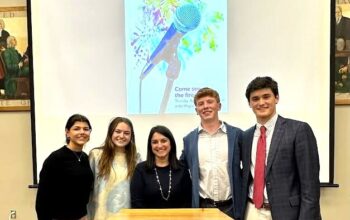![mini-SN151751[1]](https://nchscourant.comwp-content/uploads/2010/02/mini-SN1517511-300x225.jpg)
Arts Editor
According to Webster’s Dictionary, dance is “a series of rhythmic and patterned bodily movements usually performed to music.” But beyond graceful choreography, dance is an integral part of many world cultures. Some students have spent years practicing dance genres inherent to a particular culture, like Irish step dance (traditional Irish dancing), Indian classical dance, and African tribal dance.
For many who partake in cultural dance, it’s a family affair. “Indian classical dance been in my family for a long time. It’s a tradition,” sophomore Hershey Thota said. “When I was young, I wasn’t into dancing, but my mom was a dancer and thought it would be nice if I did it too.”
However for others, cultural dance is an independent choice to expand one’s horizons. Junior Keri DeTullio took African tribal dance for the first time at the New Canaan Dance Academy Summer Intensive in 2009.
Though Keri hasn’t spent years practicing it, the style still made a strong impression on her. “I really enjoyed it,” she said. “[At the New Canaan Dance Academy] we danced to African tribal music, which is basically drums. You move to the beat. So if it gets quicker, you need to get quicker as well. I would definitely like to take it again.”
The movements for different types of cultural dances are unique. Hersey describes the intricacy of each step of Indian classical dance. “There are particular eye, eyebrow, and hand movements that must be articulated to the beat of the song. It took a long time to get the expressions and was really hard to learn,” she said.
Hersey also noted that if one is off the beat in Indian dance, the bells on the costume will give you away.
Junior Anna Dearth shares the pressure to get the steps in Irish step dancing just right. “There’s a lot to think about, like the timing and movement. Everything needs to relate to the music because if the timing of your dance is off, the judges of the competition will take off points.”
Anna also stresses the amount of high-energy endurance needed to perform Irish step dancing. “It requires more stamina than other types of dance,” she said. “It’s kind of like a sport; you never leave class without sweating.”

Keri found African tribal dancing to be a little less about precision and more about the flow of movement. “African tribal dance isn’t about technique, like many other styles are,” Keri said. “It’s about moving your body in different fashions. It really hurts your back—there’s a lot of head snapping and bending your back and forth in very quick movements.”
Cultural dances aren’t just original in movement, but in costumes, which can enhance the performance. Anna described costumes in Irish step dancing as elaborate, hand-made, and embroidered creations. “It’s like a beauty pageant,” Anna said. “And there are certain trends you need to keep up with.”
Anna also explained that in Irish step dancing, one performs with hard or soft shoes for different effects. The soft shoe is made of leather, and the hard shoe is made of fiber glass, and “makes noise, like a tap shoe.”
For Indian classical dance, Hersey dances barefoot in ornate costumes complete with jewelry and bells.
In some cultural dances, wigs are expected, or at least curly hair. “Wigs balance out the costume. It’s very traditional,” Anna said of Irish step dance. “If people don’t have a wig, then they will curl their hair. A wig isn’t required, but it’s a big part of the presentation aspect of it.”
Between the movements and the elaborate costumes, cultural dancers can use up tons of energy. Anna learned first-hand how crucial energy is to a performance when she danced to a hornpipe, a “hard shoe dance” made up of 2.5 steps at a feis (an Irish stepdancing competition). “On my half step, I completely ran out of energy and one of the judges wrote that down on my marks,” she said. “Energy is important because the judges will catch it if you lag.”
Hersey also participates in dance competitions, but for Indian classical dance. “It’s a part of Indian culture,” Hersey said. “All dances tell a Hindu mythological story.”
At a performance for the Tegulu Literary and Cultural Association (TLCA) in New York City, Hersey had the gratification of seeing her hard work come to fruition. “I was so nervous before my solo dance, but after my performance a famous movie director went backstage to meet me and personally compliment me,” said Hersey. “He said my emotions were really good.”
Hersey travels to Edison, New Jersey to continue working at the dance school she’s been with since 2006. “I don’t think there are a lot of opportunities [for Indian dancing]in Fairfield County,” she said.
For some, cultural dance has become a passion. “I saw some performances and I decided to try Indian classical dance,” Hersey said. “Now, it’s literally my everything. I love it so much.”
“I’ve been practicing for 10 years now and I really love [Irish step dancing],” Rachel said. “I have competed in 6 world championships and 7 national championships, and I also teach private lessons twice a week at the New Canaan Racquet Club.”
Above all else, the love for dance drives these performers to keep practicing. “I love Irish step dancing,” Anna said. “Everything is so much fun, from the dresses, to the makeup, to the competitions. You put in a lot of hours and dedication, but when you’re standing with your trophy it’s worth all the long hours of work.”



